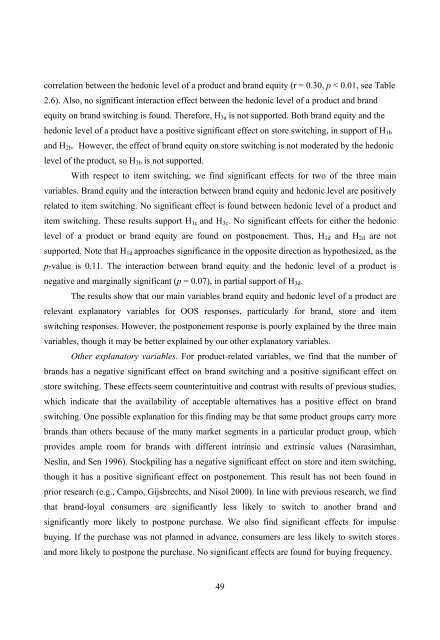Understanding Consumer Reactions to Assortment Unavailability
Understanding Consumer Reactions to Assortment Unavailability
Understanding Consumer Reactions to Assortment Unavailability
You also want an ePaper? Increase the reach of your titles
YUMPU automatically turns print PDFs into web optimized ePapers that Google loves.
correlation between the hedonic level of a product and brand equity (r = 0.30, p < 0.01, see Table<br />
2.6). Also, no significant interaction effect between the hedonic level of a product and brand<br />
equity on brand switching is found. Therefore, H3a is not supported. Both brand equity and the<br />
hedonic level of a product have a positive significant effect on s<strong>to</strong>re switching, in support of H1b<br />
and H2b. However, the effect of brand equity on s<strong>to</strong>re switching is not moderated by the hedonic<br />
level of the product, so H3b is not supported.<br />
With respect <strong>to</strong> item switching, we find significant effects for two of the three main<br />
variables. Brand equity and the interaction between brand equity and hedonic level are positively<br />
related <strong>to</strong> item switching. No significant effect is found between hedonic level of a product and<br />
item switching. These results support H1c and H3c. No significant effects for either the hedonic<br />
level of a product or brand equity are found on postponement. Thus, H1d and H2d are not<br />
supported. Note that H1d approaches significance in the opposite direction as hypothesized, as the<br />
p-value is 0.11. The interaction between brand equity and the hedonic level of a product is<br />
negative and marginally significant (p = 0.07), in partial support of H3d.<br />
The results show that our main variables brand equity and hedonic level of a product are<br />
relevant explana<strong>to</strong>ry variables for OOS responses, particularly for brand, s<strong>to</strong>re and item<br />
switching responses. However, the postponement response is poorly explained by the three main<br />
variables, though it may be better explained by our other explana<strong>to</strong>ry variables.<br />
Other explana<strong>to</strong>ry variables. For product-related variables, we find that the number of<br />
brands has a negative significant effect on brand switching and a positive significant effect on<br />
s<strong>to</strong>re switching. These effects seem counterintuitive and contrast with results of previous studies,<br />
which indicate that the availability of acceptable alternatives has a positive effect on brand<br />
switching. One possible explanation for this finding may be that some product groups carry more<br />
brands than others because of the many market segments in a particular product group, which<br />
provides ample room for brands with different intrinsic and extrinsic values (Narasimhan,<br />
Neslin, and Sen 1996). S<strong>to</strong>ckpiling has a negative significant effect on s<strong>to</strong>re and item switching,<br />
though it has a positive significant effect on postponement. This result has not been found in<br />
prior research (e.g., Campo, Gijsbrechts, and Nisol 2000). In line with previous research, we find<br />
that brand-loyal consumers are significantly less likely <strong>to</strong> switch <strong>to</strong> another brand and<br />
significantly more likely <strong>to</strong> postpone purchase. We also find significant effects for impulse<br />
buying. If the purchase was not planned in advance, consumers are less likely <strong>to</strong> switch s<strong>to</strong>res<br />
and more likely <strong>to</strong> postpone the purchase. No significant effects are found for buying frequency.<br />
49

















